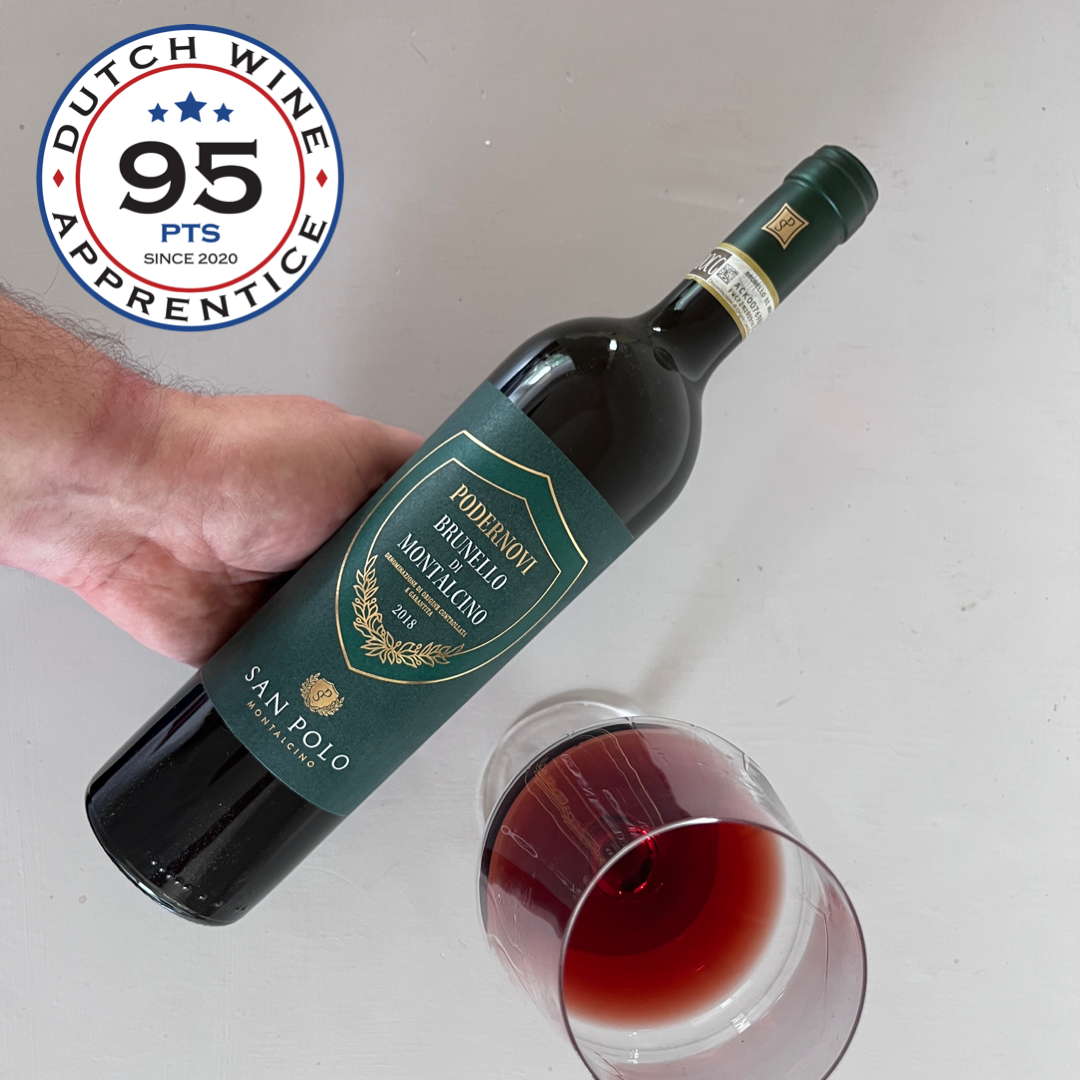Brunello di Montalcino Podernovi 2018 – Poggio San Polo.
About 70 kilometres South of the Tuscan city of Siena lays the small hilltop village of Montalcino. This photogenic medieval town is known for its world-famous wine: Brunello di Montalcino. In this review we discuss a single vineyard wine of the upcoming, high-quality, producer Poggio San Polo, their Brunello di Montalcino Podernovi 2018.
About the Region
Although the historical roots of Brunello di Montalcino must be found in the 19th century, the star of Brunello di Montalcino really started rising since the purchase of Poggio alle Mura and rebranding of it to Castello Banfi by the American Mariani brothers in the 1980’s. The interest of the American market exponentially intensified the demand for Brunello di Montalcino. Nowadays Montalcino has about 200 producers, together cultivating about 3,500 hectares of vineyards, of which about 2,100 hectares are intended for Brunello di Montalcino. Given the number of producers, the variety of styles is infinite, especially taking in consideration the wide variations in soil types, microclimates and altitudes.
According to the production rules of the Consorzio del Vino Brunello di Montalcino, Sangiovese – locally named Brunello – is the only allowed grape for both Rosso di Montalcino and Brunello di Montalcino. Rosso di Montalcino sometimes is called the little brother of Brunello. Although that saying needs to be nuanced, the comparison is understandable. Rosso di Montalcino often is made from younger Sangiovese vines. Rosso di Montalcino requires a minimum alcohol level of 12% ABV, whereas Brunello di Montalcino must be at least 12,5% ABV. Rosso may be released from the first of September of the year following the harvest. Brunello however needs a minimum of 2 years of barrel aging, followed by at least 2 months of bottle aging.
In general Rosso di Montalcino often is made to be drunk in its youth, with a mainly primary fruit driven profile, whereas Brunello di Montalcino needs time to fully develop its full potential. Rosso di Montalcino is classified as Denominazione di Origine Controlata (DOC), were as Brunello di Montalcino was the first red wine to obtain the highest Italian quality label Denominazione di Origine Controlata et Garantita (DOCG).
About the Winery
Build completely underground and fitted in the surrounding landscape, it would be easy to overlook the eco-friendly winery of San Polo. In terms of wine however San Polo is not to be missed. In 2007 Marilisa Allegrini – daughter of Valpolicella icon Giovanni Allegrini – took a share in Poggio San Polo and since 2015 the winery is wholly owned by Marilisa, Carlotta and Caterina Mastella Allegrini. In record time these power women lifted Poggio San Polo to great heights. ‘Great heights’ can be taken literally, considering Poggio means ‘hill’ in Italian and the vineyards of Poggio San Polo are located on top of a south east facing hillside, with altitudes ranging between 420 to 450 meters a.s.l. To set the scene: the vineyards of Montalcino are ranging from 120 to 650 metres a.s.l. Higher altitudes go along with larger differences between day and night temperatures, stimulating naturally freshness and aroma preservation.
San Polo owns 22 hectares of land, of which 16 hectares are planted with vines. 8 hectares are dedicated to the Brunello di Montalcino, 3 to Rosso di Montalcino and 5 to Toscana IGT. Apart from the differences in soil composition, in general the poor soils of Poggio San Polo are rich in galestro or schist with quantities of silt and clay. In 2015 – the year of the takeover – Bertani oenologist Riccardo Fratton was attracted. Since 2017 Poggio San Polo is organically certified and it carries Equalitas, BRCGS and CasaClima certifications.
About the Wine
The grapes for Poggio San Polo Brunello Di Montalcino Podernovi 2018 are coming from the south western exposed 454 meters high, 3 hectare vineyard called Podernovi. The soil of this vineyard contains a high amount of clay and a medium high amount of limestone. According to San Polo, the Podernovi vineyard is one of the coolest areas of the estate, with a wide diurnal range. The production covers 10.000 bottles.
The medium transparent ruby red wine on the nose is tempting yet pure and precise. Soft and velvet non-provocative violet is combined with ripe wild strawberry, fresh ripe cherry and fresh purple plum. Proportioned barrel expressions in the form of luxurious oriental spices like cinnamon and turmeric and a velvet mocha coffee aroma completes the picture. On the palate one will meet high concentration nestled in sophistication and delicacy. The fruit leaves the impression of soft floating ripeness. Speaking in terms of fruit, the colour of the fruit tends to be more purple dominated, with subtle hints of small red fruits. Silky wild bramble and black cherry are combined with wild raspberry and strawberry. The wine is captivating structured and profound energetic, while the long-lasting warm aftertaste does show luxurious dark oriental spices like cinnamon and paprika powder and delicate flowery black fruits.
We reward this excellent Brunello di Montalcino Podernovi 2018 with a 95 DWA-score.
Tuscany, a Journey through Five Lenses
This review is part of our project “Tuscany, a Journey through Five Lenses”. In this project we travel through one of the most exciting parts of Italy and show its different faces interpreted through leading wineries. We do this through wine reviews, background articles and interviews.
The regions we discuss are Tuscany IGP, Chianti, Bolgheri, Montepulciano and Montalcino. San Polo is our guide through the Montalcino appellation.
To stay updated about this special project subscribe to our newsletter, by clicking here. More information about the project can be found here.
Other wines by Poggio San Polo in this project:
This wine is reviewed by our own Hermen Jansen.
Price: €125
Taste date: July 2023
Score: 95/100 DWA Score
Website: Poggio San Polo

